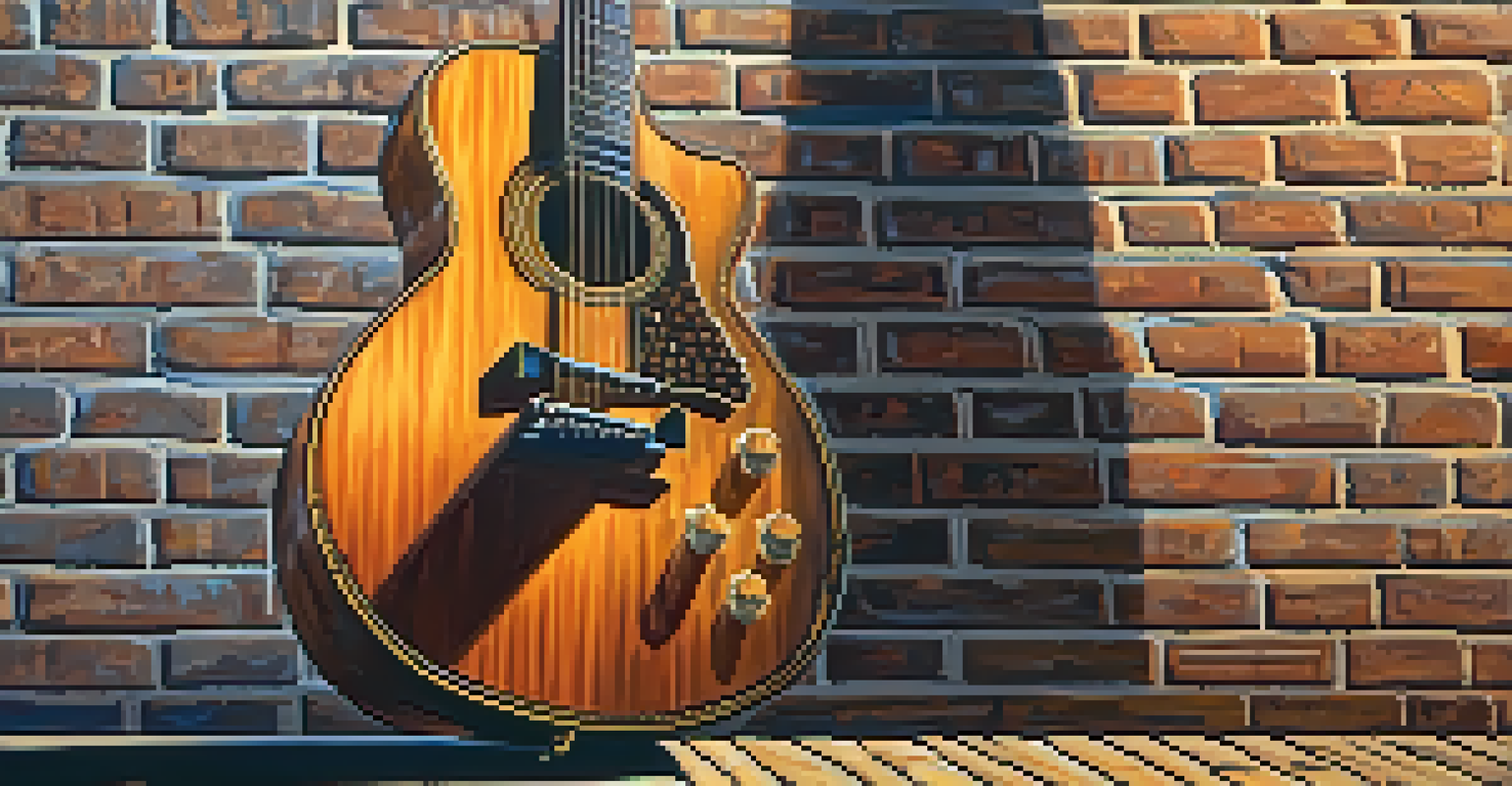Using Modes to Enhance Your Guitar Improvisation Skills

What Are Musical Modes and Why They Matter
Musical modes are essentially scales derived from the major scale, each with its unique flavor. They provide different emotional contexts that can enrich your improvisation. By understanding modes, you can create more varied and interesting solos, deviating from the standard minor and major scales.
Music is the shorthand of emotion.
For example, the Dorian mode has a jazzy, smooth feel, while the Phrygian mode brings a more exotic and mysterious vibe. This variety allows you to express different moods and styles in your playing. Knowing the modes gives you a toolbox of sounds to draw from as you improvise.
Ultimately, modes transform your improvisational palette, making your guitar solos more engaging and dynamic. They’re not just theoretical concepts; they’re practical tools that can elevate your music. So, let's dive deeper into how to use these modes effectively!
Understanding the Seven Common Modes
The seven common modes are Ionian, Dorian, Phrygian, Lydian, Mixolydian, Aeolian, and Locrian. Each mode has its own distinct interval structure, which gives it a unique sound. For instance, the Ionian mode is simply the major scale, bright and uplifting, while the Locrian mode is often described as dissonant and unstable.

To grasp these modes better, think of them as flavors of ice cream. Just as vanilla, chocolate, and strawberry offer different tastes, each mode provides a different sonic experience. The more you experiment with them, the more you’ll find which modes resonate with your musical style.
Develop Your Unique Guitar Voice
Using modes as a foundation can help you develop a distinctive sound that reflects your personal style.
By understanding these modes, you can choose the right one to match the emotion of the piece you’re playing. This knowledge will empower you to make informed choices during your improvisation, enhancing your overall musicianship.
How to Practice Modes on Your Guitar
Practicing modes involves more than just memorizing their shapes on the fretboard. Start by playing through each mode in various positions to internalize their sounds and feel. You can also use a metronome to keep a steady rhythm, gradually increasing your speed as you become more comfortable.
To play a wrong note is insignificant; to play without passion is inexcusable.
Incorporating backing tracks can make practicing modes more enjoyable and realistic. Play over a track in a specific key, and switch between modes to see how they interact with the chords. This real-world application helps reinforce your understanding and builds confidence in using modes.
Additionally, try improvising short melodies using a specific mode. This not only helps with creativity but also allows you to explore the emotional depth of each mode. Over time, this practice will lead to more fluid and expressive improvisation.
Combining Modes for Unique Soundscapes
One of the exciting aspects of modes is that you can combine them to create unique soundscapes. For example, you might use the Dorian mode for a solo, then transition into the Mixolydian mode to add a touch of brightness. This blending can create an engaging musical narrative.
Think of it like cooking; sometimes, the best dishes come from combining different ingredients. Similarly, merging modes can produce unexpected and delightful musical flavors. Experimenting with these combinations can lead to new ideas and inspire your creativity.
Musical Modes Enhance Improvisation
Understanding musical modes enriches your solos by providing diverse emotional contexts and sonic flavors.
Be mindful of the harmonic context when combining modes. Ensure that the chords you play over support the modes you are using. This harmony will create a cohesive sound that feels intentional and polished.
Using Modes in Different Musical Genres
Modes are prevalent in various musical genres, each bringing a unique character to the style. For instance, the Dorian mode is often used in jazz and blues, while the Lydian mode is popular in progressive rock. Understanding how different genres utilize modes can inspire your improvisation.
If you listen to a jazz guitarist, you might notice how they effortlessly switch between modes to create tension and resolution. This technique can also be applied in rock, where modal shifts can add depth to solos. By studying these examples, you can incorporate similar strategies into your own playing.
Don’t hesitate to experiment with modes in genres you love. Try using a Phrygian mode in a pop context or Mixolydian in a country tune. This exploration can lead to fresh ideas and new sounds that set your playing apart.
Analyzing Solos from Great Guitarists
One of the best ways to learn about modes is to analyze the solos of great guitarists. Artists like Joe Satriani or John Mayer often utilize modes to enhance their improvisation. By breaking down their solos, you can identify which modes they use and how they incorporate them.
Start by picking a solo you admire and transcribing it. As you transcribe, pay attention to the modes being used and the emotional impact they create. This exercise not only improves your ear but also deepens your understanding of how modes function in a musical context.
Modes Offer Unique Genre Applications
Different genres utilize modes in unique ways, allowing guitarists to experiment and create fresh sounds.
Additionally, try to emulate parts of these solos in your practice. This mimicry will help you internalize the sounds of the modes and develop your own voice as a guitarist. Remember, learning from others can significantly accelerate your growth.
Developing Your Own Voice with Modes
Ultimately, the goal of using modes is to develop your own unique voice as a guitarist. While learning how to play various modes is essential, how you express them is what makes your playing stand out. Use modes as a foundation, but don’t hesitate to add your personal flair.
Think of famous guitarists like Jimi Hendrix or Eric Clapton; they all had a unique sound that evolved over time. By experimenting with different modes and techniques, you can discover what resonates with you. This exploration is vital for personal growth as a musician.

As you get more comfortable with modes, challenge yourself to improvise without preconceived ideas. Allow your emotions to guide your playing and trust your instincts. This authenticity will shine through in your music, making it truly your own.